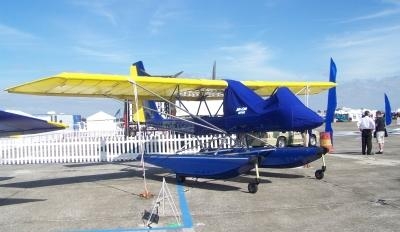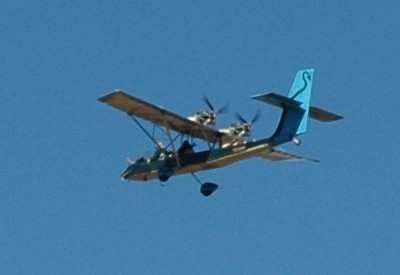There Is ... At Least For The Author ... It's The AirCam
By David Juwel
In part one of this series, I posed the question "Is there a perfect airplane?" And while the answer will not be the same for everyone, for me, it is the AirCam.

This is a go-anywhere airplane. You can land in remote jungle clearings, on a desert, a beach, a riverbed, or on a deserted road. You can safely make long over-water trips. You can fly through canyons and valleys, and over the mountaintops. You can fly low and over hazardous areas in complete safety. By adding floats, you add thousands of more places where you can land, making the aircraft even more utilitarian.
The AirCam is a slow, highly utilitarian, safe and fairly inexpensive aircraft to operate, and it meets or exceeds the 25 specifications I laid out in the first article:
- It has unobstructed visibility, both forward, up and down.
- It can carry two people (three if you use the baggage space).
- It has a useful load that exceeds the number of seats, cargo and full fuel (over 600 lbs.).
- It can fly safely at an exceptionally slow speed and still maintain stable control.
- It is able to cruise at better than highway speed in a 20 mph headwind.
- It is environmentally friendly with a minimal noise signature at reduced RPM.
- You can easily bail out of it with a personal parachute. You can also comfortably wear life and survival vests while flying.
- It is heavy enough to fly in moderate winds and turbulence.
- It has simplistic construction and is easy to maintain.
- It can be built with a reinforced undercarriage and larger tires added for unprepared surfaces.
- You can add fuselage or wing attach points for external fuel pods, baggage pods or other utility purposes.
- It has a large separate cargo area (with tie-downs) and the rear seat can be removed for additional space, so you don’t need wing hard-points for additional pods. But that could still be an option.
- You can add amphibious floats for both land and water operations.
- It has two engines with minimal asymmetrical thrust when one is shut down.
- You can practice noise abatement by reducing the RPM of the 100 HP Rotax engines. You can even climb at a reduced RPM.
- You can fly at 15,000+ feet with this aircraft.
- This aircraft is kit-built and it doesn’t cost more to own and operate than a high-end Class C, or low-end Class A, recreational vehicle ($100,000-$150,000 new).
- This aircraft has sufficient fuel to fly without constantly landing to refuel, and you can even add an extra fuel tank to the cargo area for longer distances.
- This aircraft has the ability to land and take-off in 300 feet or less.
- This aircraft has the ability to climb at 1,500 fpm (or 300 fpm on a single engine) at gross weight.
- This aircraft has the ability to attach photography and video equipment to document the flying experience.
- This aircraft can have a heavy-duty electrical system and battery installed.
- This aircraft has the ability to add skies, floats, all terrain tires, and other accessories useful to survival and remote operation.
- This aircraft has the ability to function in the utility category and be rugged enough to be used in remote locations such as short grass runways, remote clearings, beach, and gravel road areas.
- This aircraft has dual controls and instrumentation.

The preceding facts and figures do not represent the sum total of this aircraft’s abilities. For example. it can be used as an aerial ambulance by flying a doctor, nurse and field medical supplies to remote areas. It can be used for agricultural spraying by adding a tank and sprayers. It is a superb photography/video platform. It can be used for missionary work by providing supplies and remote access. It can be used for search and rescue; a para-rescue person could easily jump from it to reach an inaccessible area as a first responder. It can be used for exploration and surveying. It can be used for law enforcement aerial patrols and command communications. It can be used for damage assessment (flood, tornado, and hurricane), searching for missing persons, and looking for prohibited crops. It can be used for pipeline patrolling and forestry surveys. Almost anything that can be done in the air can be done with an AirCam. While a lot of different aircraft can also do these things, it’s the
AirCam’s ability to loiter about over dangerous terrain in total safety with unimpeded visibility that makes it so much more valuable.
This is indeed a durable aircraft. One pilot flew his AirCam over 14,000 miles for a documentary. Another flew over 8200 miles in his AirCam without a ground crew. Each year, the AirCam factory flies their demonstration-display aircraft from Sebring, Florida to Oshkosh, Wisconsin (and return) for the annual fly-in. That’s a 2400 mile round trip. The only thing that hasn’t been done with the aircraft (yet) is to fly around the world in one. If any plane could do it, in my estimation at least, this one certainly can.
Is there anything the AirCam can’t do? Yeah, well, it’s not a fast bird, but then bird’s don’t fly that fast anyways.
I have not found any other aircraft that can so completely dominate the aerial environment, and be as thoroughly and safely mission capable as the AirCam is; especially one that many of us can afford.
You owe it to yourself to take a ride in one. Use caution though, it’s very addictive!
 ANN's Daily Aero-Linx (04.16.24)
ANN's Daily Aero-Linx (04.16.24) Aero-News: Quote of the Day (04.16.24)
Aero-News: Quote of the Day (04.16.24) Airborne 04.10.24: SnF24!, A50 Heritage Reveal, HeliCycle!, Montaer MC-01
Airborne 04.10.24: SnF24!, A50 Heritage Reveal, HeliCycle!, Montaer MC-01 Airborne 04.12.24: SnF24!, G100UL Is Here, Holy Micro, Plane Tags
Airborne 04.12.24: SnF24!, G100UL Is Here, Holy Micro, Plane Tags Airborne-Flight Training 04.17.24: Feds Need Controllers, Spirit Delay, Redbird
Airborne-Flight Training 04.17.24: Feds Need Controllers, Spirit Delay, Redbird




